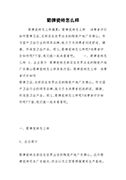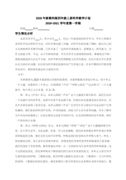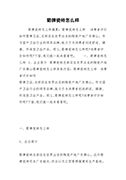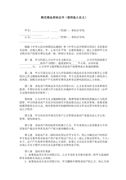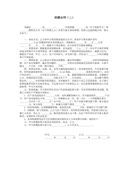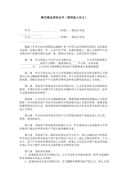Module 5 Rules and suggestions(通用2篇)九年级英语教案
Module 5 Rules and suggestions(通用2篇)
Module 5 Rules and suggestions 篇1
unit 1 you must keep to the path
i. teaching material analyzing 教材分析
本课以“rules and suggestions”为话题,以 “mr. jackson告诉人们爬长城时应该注意的一些事项为主题,通过听、读、说训练,要求学生重点掌握规则和建议的表达方法。通过本课的学习,学生将重点掌握情态动词的用法,并能运用所学知识说一些应注意的规则和提一些建议。
activity 1要求学生看中国的长城图,给来参观的游客说一些规则,提一些建议。
activity 2要求学生听录音,利用所给词汇回答问题,并通过再次听录音检查答案,从而为activity 3 的对话作准备。
activity 3听读一段mr. jackson给大家介绍一些规则和提建议的对话,在让学生了解爬长城应注意事项的同时,学习一些关于说规则、提建议的句式。
activity 4根据对话内容选择最佳答案。
activity 5要求学生就mr. jackson提的规则和建议做一个笔记。
ii. teaching goals教学目标
skill focus
听
listen to the dialogue about the rules and suggestions to the great wall.
说
talk about the rules and suggestions when making a trip
读
read the dialogue about the rules and suggestions to the great wall.
写
write about rules and suggestions to protect our environment
language goals
语言目标
1.重点词汇
rule, suggestion, rope, stream, clear, starving
2.短语
keep...to, lead the way
3.everyday english
i’m starving! i think that’s all.
ability goals
能力目标
enable the students to talk about the rules and advice using model verbs.
learning ability goals 学能目标
help the students learn how to talk about the rules and advice using model verbs.
teaching methods 教学方法
listening and speaking. individual, pair or group work.
teaching important/difficult points教学重难点
1. master the new phrases and sentence pattern
2. make the students be able to talk about rules and suggestion
teaching aids
教具准备
a tape recorder, a projector and a blackboard
ⅲ. teaching procedures and ways 教学过程与方式
step i revision
revise the new words and some phrases by reading together.
step ii warming up and lead-in
talking about some of the school rules the students are obeying. let the students pre-know what are rules and the pattern of saying rules included must, mustn’t, should, shouldn’t etc.
step iii look and say
show the students a picture of the great wall. have the students think and give some rules and advice to the visitor.
step ⅳ listen and answer
read the words in the box first. listen to the tape to get the general idea. then listen again and try to get the answers. check the answers with the students.
step ⅴ listen and read
1. listen to the tape for the first time with the books open.
2. listen and repeat after the tape. pay special attention to the rules and suggestions mr. jackson gave them.
3. read after the teacher. analyze the dialogue. teach the language points and useful expressions.
4. choose the best answers in activity 4. ask a couple of students to show off their answers.
5. let the students find out the rules and suggestions mr. jackson gave them in the dialogue, try to finish the blank in activity 5. check with the students.
step ⅵ pairs work
work in pairs. discuss what rules and suggestions we should obey to protect our environment. write down their answers. ask pairs to show out their answers.
step ⅶ summary
read the new words , phrases and useful expressions and the pattern of rules.
step ⅷ homework
1. read the dialogue
2. write some rules or suggestions if you are watching a film in the cinema.
teaching resources 教学资源库
ⅰ. 情态动词
情态动词有can (could), may (might), must, have to, shall (should, will (would), dare (dared), need (needed), ought to等。 情态动词无人称和数的变化;不能单独使用,必须与其后的动词原形构成谓语。
1. can, could
1) 表示能力(体力、知识、技能)。 例如:
can you lift this heavy box?(体力)
mary can speak three languages.(知识)
can you skate?(技能)
此时可用be able to代替。can只有一般现在时和一般过去式;而be able to
则有更多的时态。例如:
i’ll not be able to come this afternoon. (一般将来时)
当表示“经过努力才得以做成功某事”时应用be able to,不能用can。如:
he was able to go to the party yesterday evening in spite of the heavy rain.
2) 表示请求和允许。 例如:
-----can i go now?
-----yes, you can. / no, you can’t.
此时可与may互换。在疑问句中还可用could, might代替,但could, might 并不表示过去式,只是语气更委婉。它们不能用于肯定句和答语中。 例如:
---- could i come to see you tomorrow?
---- yes, you can. (no, i’m afraid not.)
3) 表示客观可能性(客观原因形成的能力)。例如:
they’ve changed the timetable, so we can go by bus instead.
this hall can hold 500 people at least.
4) 表示推测(惊讶、怀疑、不相信的态度),用于疑问句、否定句和感叹句中。
can this be true?
this can’t be done by him.
how can this be true?
2. may, might
1) 表示请求和允许。might比 may语气更委婉,而不是过去式。否定回答时可用can’t 或mustn’t,表示“不可以,禁止”。 例如:
----might/ may i smoke in this room?
---- no, you mustn’t.
---- may/might i take this book out of the room?
---- yes, you can. (no, you can’t / mustn’t. )
用may i...?征徇对方许可时比较正式和客气,而用can i...?在口语中更常见。
2)用于祈使句,表示祝愿。 例如:
may you succeed!
3) 表示推测、可能性(不用于疑问句)。might不是过去式,它所表示的可能性比may小。 例如:
he may /might be very busy now.
your mother may /might not know the truth.
3. must, have to
1) 表示必须、必要。例如:
you must come in time.
在回答引出的问句时,如果是否定的,不能用mustn’t(禁止,不准),而用needn’t, don’t have to(不必)。例如:
---- must we hand in our exercise books today?
---- yes, you must.
---- no, you don’t have to / you needn’t.
2) must是说话人的主观看法,而have to则强调客观需要。must只有一般现在时,have to 有更多的时态形式。 例如:
his play isn’t interesting, i really must go now.
i had to work when i was your age.
3) 表示推测、可能性(只用于肯定的陈述句)例如:
you’re tom’s good friend, so you must know what he likes best.
your mother must be waiting for you now.
4. dare, need
1) dare作情态动词用时, 常用于疑问句、否定句和条件从句中, 过去式形式为
dared。例如:
how dare you say i’m unfair?
he daren’t speak english before such a crowd, dare he?
if we dared not go there that day, we couldn’t get the beautiful flowers.
2) need 作情态动词用时, 常用于疑问句、否定句。在肯定句中一般用must, have to, ought to, should代替。 例如:
you needn’t come so early.
---- need i finish the work today?
---- yes, you must. / no, you needn’t.
3) dare和 need作实义动词用时, 有人称、时态和数的变化。在肯定句中,dare后面常接带to的不定式。在疑问句和否定句中,dare后面可接带to或不带to的不定式。而need后面只能接带to的不定式。 例如:
i dare to swim across this river.
he doesn’t dare (to) answer.
he needs to finish his homework today.
5. shall, should
1) shall 用于第一人称,征求对方的意见。 例如:
what shall we do this evening?
2) shall 用于第二、三人称,表示说话人给对方的命令、警告、允诺或威胁。
you shall fail if you don’t work hard. (警告)
he shall have the book when i finish it.(允诺)
he shall be punished.(威胁)
6. will, would
1) 表示请求、建议等,would更委婉。例如:
will / would you pass me the ball, please?
2) 表示意志、愿望和决心。例如:
i will never do that again.
they asked him if he would go abroad.
3) would表示过去反复发生的动作或某种倾向。would表示过去习惯时比used
to正式,且没有“现已无此习惯”的含义。例如:
during the vacation, he would visit me every other day.
the wound would not heal.
7. should, ought to
1) should, ought to表示“应该”,ought to表示义务或责任,比should语气重。
i should help her because she is in trouble.
you ought to take care of the baby.
2) 表示劝告、建议和命令。should, ought to可通用,但在疑问句中常用should。
you should / ought to go to class right away.
should i open the window?
3) 表示推测
should , ought to (客观推测), must(主观推测)。
he must be home by now. (断定他已到家)
he ought to/should be home by now.(不太肯定)
this is where the oil must be. (直爽)
this is where the oil ought to/should be. (含蓄)
Module 5 Rules and suggestions 篇2
unit 2 you mustn’t move.
课题
module 5 unit 2 you mustn’t move
课型
reading and writing
第 2 课时
教学
目标
知识目标to get information from the reading material about the eventto learn more expressions and new vocabulary
能力目标to write some rules and suggestions about sth.
情感目标提高文化素质和环保意识
内容
分析
重 点key vocabulary and some useful expressions.
难 点the usage of “must/have to/should/can/may/ought”.
教法学法
top-down approach
教具
学具 multimedia
教学程序
教材处理
师生活动
时间step 1: have a dictationstep 2: lead to the new point.step 3: look and talkactivity 1step 4: (activity3)fast reading ,then choose the best answer.step 5: read the passage carefullystep6:homework for todayrecite all the phrases and important sentences in the first three paragraphs.《中华一题》get the students to go over the set phrases . let them write the useful expressions down and then the teacher shows the answers.t: please look at these three pictures .t asks: “ what are they doing?”students answer: “ they are camping.”t says: “ yes, they are camping. do you like camping?”students answer: “yes.”t says, “me, too. but i am afraid of something dangerous in the forest. such as bears, tigers and so on.now today let’s see what happened to the students in the story?look at the picture and answer1.what do you think the bear is doing?2.what do you think the people in the tent should do ?get the students to talk about it ,and then tell it to the class.get the students to read the passage as quickly as they can ,then do activity 3.after 5 minutes, ask one student to show his answers. then the teacher shows the right answers.please read the passage one by one paragraph( paragraphs 1—3)there are three tasks for the students.1. get the students to read it.2. get the students to translate it.3. get the students to find out the importances.at first, the teacher will ask one student to read it.then , t asks, “ which sentence can’t you understand, please ask me.”finally, get the students to show the importances to the calss. and the teacher will explain some important points to the students ,after that, if they have any question, they can ask the teacher to help them.
教学后记课时备课表(教案)
课题
module 5 unit 2 you mustn’t move
课型
reading and writing
第 3 课时
教学
目标
知识目标to get information from the reading material about the eventto learn more expressions and new vocabulary
能力目标to write some rules and suggestions about sth.
情感目标提高文化素质和环保意识
内容
分析
重 点key vocabulary and some useful expressions.
难 点the usage of “must/have to/should/can/may/ought”.
教法学法
top-down approach
教具
学具 multimedia
教学程序
教材处理
师生活动
时间step 1: have a dictationstep 2: go on learning the passage.step 3: answer the questions in activity 2..step 4: homework for todayrecite all the phrases and important sentences in this module.《中华一题》get the students to go over the set phrases in unit 2 . let them write the useful expressions down and then the teacher shows the answers.please read the passage one by one paragraph( paragraphs 4-5)there are three tasks for the students.4. get the students to read it.5. get the students to translate it.6. get the students to find out the importances.at first, the teacher will ask one student to read it.then , t asks, “ which sentence can’t you understand, please ask me.”finally, get the students to show the importances to the calss. and the teacher will explain some important points to the students ,after that, if they have any question, they can ask the teacher to help them.get the students to do it first.then ask five students to answer these questions.at last, show the right answers to the students.
教学后记


